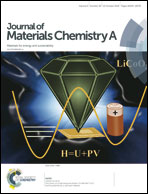Crystallographic orientation–surface energy–wetting property relationships of rare earth oxides†
Abstract
Controlling the wetting property of ceramics, which is characterized by their water contact angles (WCAs), is of great interest because of their better thermal and chemical robustness compared with polymer materials. Among many ceramics, rare earth oxides (REOs) have attracted attention because of their high WCA (∼115°). Although several non-wetting mechanisms of REOs have been proposed thus far, the intrinsic mechanism has not been clarified yet due to the lack of information on crystallographic orientation–surface energy (SE)–WCA relationships. Here we report the WCA of (001), (110), and (111) oriented REO epitaxial films, which have different surface energies. We found that the WCA of fresh REO epitaxial film surfaces, which were prepared using a pulsed laser deposition technique, strongly depends on the crystallographic orientations, WCA(111) > WCA(110) > WCA(001), which reflects the differences in surface energy; SE(111) < SE(110) < SE(001). Moreover, we found that the WCA on REOs increases rapidly and converges to about 80° upon exposure to ambient air, regardless of the crystallographic orientation, likely due to surface adsorption of airborne carbon species. The present finding of ‘There is a strong correlation between the crystallographic orientation, wetting property and the surface energy’ is of great importance for the understanding of the wetting properties of ceramics.



 Please wait while we load your content...
Please wait while we load your content...